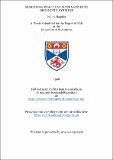Files in this item
Search for practical alternatives to organotin hydrides
Item metadata
| dc.contributor.advisor | Walton, John | |
| dc.contributor.author | Baguley, Paul A. | |
| dc.coverage.spatial | 251 p. | en_US |
| dc.date.accessioned | 2018-07-16T09:11:47Z | |
| dc.date.available | 2018-07-16T09:11:47Z | |
| dc.date.issued | 1998 | |
| dc.identifier.uri | https://hdl.handle.net/10023/15419 | |
| dc.description.abstract | A summary of the tin hydride method of generating radicals in organic synthesis is presented, followed by illustrative examples of other methods available for mediating radical reactions, with a particular emphasis on recent developments. This is followed by four chapters describing our efforts to introduce alternative methods for generating radicals. A range of l-alkylcyclohexa-2,5-diene-l-carboxylic acids have been prepared by Birch reduction-alkylation methodology and shown to generate the corresponding alkyl radical by thermal initiation with dibenzoyl peroxide. The 1-benzyl, cyclopentyl and t-butyl precursors (17,15, and 16 respectively), acted as sources of radicals which were trapped with cyclohexenone to give the corresponding 3-alkylcyclohexanone adducts in yields of 52%, 30% and 25% respectively. Addition products were also observed when acrylonitrile and vinyl benzoate were employed as the radical traps. 1-[2-(Cylohex-2-enyloxy)ethyl]cyclohexa-2,5-diene-l-carboxylic acid 32 and l-[2-(6,6- dimethylbicyclo[3.1. l]hept-2-en-2-ylmethoxy)ethyl]cyclohexa-2,5-diene- 1-carboxyhc acid 33 are new compounds which were prepared in four straightforward steps from cyclohexene and β-pinene respectively. The route leading to acid 32 involved the preparation of four new compounds and three new compounds were prepared during the synthesis of acid 33. When refluxed in benzene in the presence of dibenzoyl peroxide, carboxylic acid 32 generated a primary alkyl radical which cyclised to yield 7- oxabicyclo[4.3.0]-nonane in 55% yield. The tin-mediated cyclisation of 3-(2'- iodoethoxy)cyclohexene 36 yielded the same compound in 60% yield, in addition to 3- ethoxycyclohexene (12%). Similarly, carboxylic acid 33 generated a primary alkyl radical which cyclised to yield the new compound oxacyclopentane-3-spiro-2-6,6- dimethylbicyclo[3.1.1]heptane in 10% yield. The tin-mediated cyclisation of 6,6-dimethyl- 2-(2-iodoethoxymethyl)bicyclo[3.1.1]hept-2-ene 37 yielded the same spiro compound in 31% yield. EPR spectroscopic studies provided direct evidence for the formation of the cyclohexadienyl radicals from all of the carboxylic acids investigated. Carboxylic acids 15- 17 and l-[2-(ethenyloxy)benzyl]cyclohexa-2,5-diene-l-carboxylic acid 34 also generated alkyl radicals which were clearly observed by EPR spectroscopy. The carboxylic acid radical precursors would have yielded products in higher yields if the competitive loss of a hydroxyformyl radical did not occur. An account of our work directed towards the synthesis of l-phenylcyclohexa-2,5-diene-l- carboxylic acid 8 is given. Thus, 1,4-dihydrobiphenyl was deprotonated with BuLi, added to CO2 and the isomeric acid, 3-carboxylic acid-3,4-dihydrobiphenyl was removed by reacting with maleic anhydride to give the Diels-Alder adduct. 2-(Cyclohex-2-enyloxy)ethyl l-phenylcyclohexa-2,5-diene-l-carboxylate 24 was treated with dibenzoyl peroxide to afford 7-oxabicyclo[4.3.0]nonane in yields of 32-36%. A variety of N-carboalkoxy-l,2-dihydropyridines have been prepared from the reaction of pyridine and the appropriate chloroforniate in the presence of NaBH₄. EPR studies have shown that these esters produce aza-cyclohexadienyl radicals on photolysis in the presence of di-t-butyl peroxide, but no decarboxylation was observed. These compounds do not generate alkyl radicals efficiently when reacted with dibenzoyl peroxide. In each case the major product identified was the corresponding benzoate ester, which resulted from the combination of an alkoxycarbonyl radical and a phenyl radical. | en_US |
| dc.language.iso | en | en_US |
| dc.publisher | University of St Andrews | |
| dc.subject.lcc | QD412.S7B2 | |
| dc.subject.lcsh | Organotin compounds | en |
| dc.title | Search for practical alternatives to organotin hydrides | en_US |
| dc.type | Thesis | en_US |
| dc.type.qualificationlevel | Doctoral | en_US |
| dc.type.qualificationname | PhD Doctor of Philosophy | en_US |
| dc.publisher.institution | The University of St Andrews | en_US |
This item appears in the following Collection(s)
Items in the St Andrews Research Repository are protected by copyright, with all rights reserved, unless otherwise indicated.

